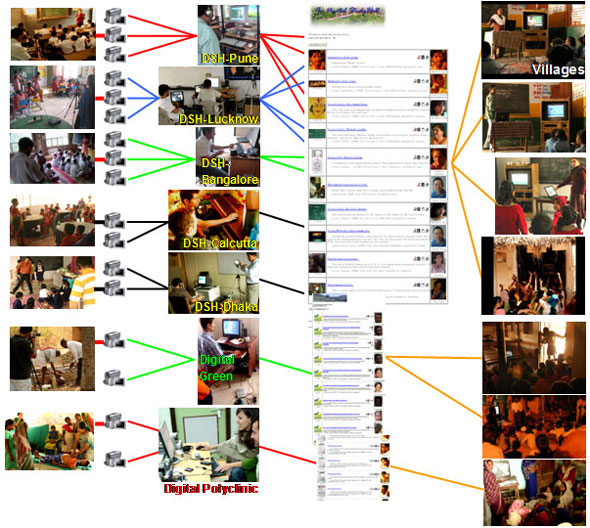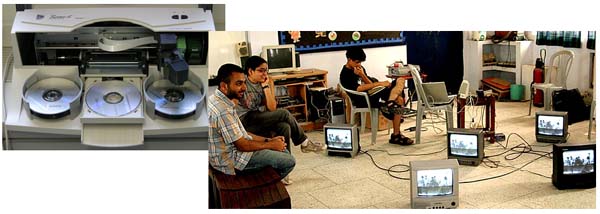Technology for Sharing Community-Generated Video
Technically, what we have described so far is akin to a user-generated video sharing system. The question we face is how to build such a "Web 2.0" application without having to replicate the "Web 2.0" physical infrastructure in slums and rural areas. A best example illustrating our approach is what we call the "Postmanet," in which computer network packets normally placed on wires are now placed on DVDs transported by the postal system. On top of this low-level connectivity provided by the Postmanet, we build the rest of the distributed DSH database in a way that is conceptually similar to how an existing peer-to-peer content sharing network works.
The above figure illustrates the end-to-end system. On the far left is a fleet of digital camcorders serving as the eyes and ears (or input devices) of the system. They are shared among the DSH participants who contribute content into the system and they may be constantly on the go. The resulting tapes are funneled to the nearby hubs for digitizing and uploading into the local databases, which communicate with each other via the Postmanet and synchronize their content. On the far right, shared TVs and DVD players economically serve as the output devices of the system.

In this arrangement, we have chosen an approach exploiting practical, cheap, and well-understood "light-tech" metaphors (such as TVs, DVD players, camcorders, the postal system, and cell phones) at the fringe, while concentrating the "higher-tech" elements (those employed in a hub, such as elements of a distributed database, significant storage, digitizers, DVD-burning robots, conventional Internet connectivity, and a suite of other software tools) inside the hybrid "network." This two-tier system makes an Internet-like system accessible to the underprivileged, so that anyone can contribute content to the "network," and anyone can consume content made available on the "network." The same system may be used for other areas of work (such as agriculture, health care, and political activism).

The higher-level DSH goals, such as producing a People's Database of Everything freely accessible to all, and harvesting community participation, however, are technology-neutral and target audience-neutral. So, for example, in countries where there is a sizeable middle-class population today, the DSH database may be accessible via PCs, broadband, and/or portable devices (like the Zune or the iPod); a DSH mediator may even play her role remotely over the network. When, in the future, technology options improve in poorer regions, we may also provide a smooth migration path, transitioning gradually from "light-tech" delivery to "higher-tech" delivery, and improving service quality in the process. In this sense, we hope DSH will be able to play a role in transforming the education landscape, spanning a continuum across the dimensions of space (from the disadvantaged to the middle-class) and time (from now into the future)!